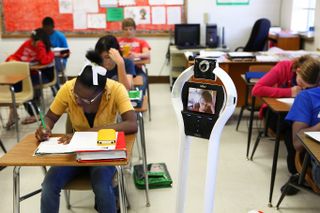The use of telepresence robots in education might seem new or science fiction-like to some but Dr. Lori Aden has been helping to facilitate students and their telepresence robots for almost a decade.
Aden is the program coordinator for Region 10 Education Service Center, one of 20 regional service centers that support school districts in Texas. She oversees a small fleet of 23 telepresence robots that are deployed as needed to assist students in the region.
These telepresence robots act as avatars for students who cannot attend school long-term for various health or other reasons, providing a more immersive experience than video conferencing via a laptop.
“It puts the control of learning back in the student’s hands,” Aden says. “If there is group work, the child can drive the robot over to the little group. If the teacher moved over to the other side of the classroom, the laptop was gonna stay one direction unless another person moves it. [With the robot] the child can actually just twist and turn and drive the robot.”
Telepresence Robot Technology

Telepresence robots are produced by several companies. Region 10 in Texas works with VGo robots produced by VGo Robotic Telepresence, a division within Massachusetts-based Vecna Technologies.
Steve Normandin, product manager at Vecna, says they have about 1,500 VGo robots currently deployed. In addition to being used in education, these robots are also utilized by the healthcare industry and other industries, and can be purchased for under $5,000 or rented for a few hundred dollars per month.
The robot moves at a slow pace that is designed to be harmless. “You're not going to hurt anybody,” Normandin says. During a demo for this story, a Vecna employee logged into the VGo at the company’s office and intentionally crashed the device into the company’s printer – neither device was harmed.
Students can press a button that causes the robot’s lights to flash indicating they have their hand raised, like an in-class student might do. However, Normandin believes the best part about VGos in school settings is they allow students to interact with classmates in the hallways between classes and one-on-one or in small groups. “Nothing's better than being there personally yourself, but this is a far cry from just the laptop or the iPad with FaceTime,” he says.
Aden agrees. “The social aspect is huge,” she says. “It just lets them be a kid. We even dress the robots up. We'll put a t-shirt on or we've had little girls put tutus and bows on theirs. It's just a way to help them feel as normal as possible being around other kids in the classroom.”
Other children also learn by interacting with the remote student. “They're learning empathy, they're learning that not everybody is as lucky as they are not as healthy as they are. It's a two-way street there,” Aden says.
Telepresence Robot Tips for Educators

Region 10 students who have utilized the robots have included those with severe physical or cognitive impairments, ranging from car accident victims to cancer patients and immunocompromised students. Telepresence robots have also been used as avatars by students who have had behavioral problems and are not yet ready to be reintegrated fully with other students.
Setting up a student with a robot does take some time, however, so they’re not deployed for students with short-term absences such as a vacation or temporary illness. “If it's only a couple of weeks, it's not worth it,” Aden says.
Aden and colleagues at Region 10 regularly talk with educators in Texas and beyond about effectively using the technology and they have put together a resource page for educators.
Ashley Menefee, an instructional designer for Region 10 who helps oversee the robot telepresence program, says that educators looking to deploy robots should check the wifi at the school beforehand. Sometimes wifi may work great in one area but the student’s route will take them to a place where the signal is weaker. In these instances, the school will need a wifi booster or the student will need a “bot buddy” who can put the robot on a dolly and take it between classes.
For teachers, Menefee says the secret to effectively integrating a remote student into the class via robot is to ignore the technology as much as possible. “We really suggest that they treat the robot as if it was a student in the classroom,” she says. “Make sure that the students feel like they're included in the lesson, ask them questions.”
Aden adds that these devices don’t put the same type of strain on teachers that hybrid classes conducted via video conferencing did in the early stages of the pandemic. In those situations, the teacher had to adjust their audio and camera and master in-class and remote management simultaneously. With the VGo, “The child has full control of that robot. The teacher doesn't have to do a darn thing.”

